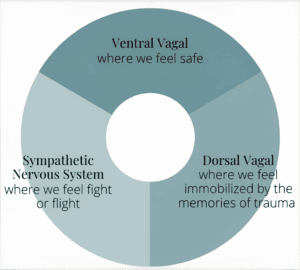The Hidden Language of Your Nervous System
This article has been researched and written by Moni El Ramlawy. AI has not been used in producing this article.
Before you say, “I’m fine,” your nervous system has already responded. That response doesn’t come from logic, reasoning, or even conscious thought – it comes from your body’s survival system. Polyvagal Theory, developed by Dr. Stephen Porges, offers a powerful lens to understand how our nervous systems respond to our emotional triggers. It tells us that we’re not just reacting to the world through our thoughts – we’re constantly scanning for cues of safety and danger. According to this theory, our nervous system navigates three main states to manage stress. When we understand them, we begin to decode the hidden language our body speaks every day.

1. Safety & Connection (Ventral Vagal State)
This is your state of presence and regulation. When you’re in ventral vagal, your body feels safe and calm. This is your “I’m okay, I’m connected, I can think clearly” state. In this state, you can experience joy, healing, intimacy, and connection. You can express emotions, problem-solve, and reflect.
2. Alert (Sympathetic State)
This is a state of threat, and when your nervous system detects threat (real or perceived), it shifts into action. This is what we call the fight-or-flight response. You might feel agitated or anxious. Your heart races, muscles tense, and everything feels urgent. This is not a weakness; it’s your body trying to protect you, and while this state is essential for survival, being stuck there for too long can lead to burnout or chronic stress.
3. Shutdown (Dorsal Vagal State)
This state is like an emergency brake. When the threat feels overwhelming and escape seems impossible, the body goes into a state of freeze. You may feel spacey, numb, or exhausted. It can look like depression, but it’s actually a survival response when fight-or-flight no longer works.
Learning to notice these states helps you recognize your emotions. When you begin to understand how your nervous system works, you gain the power to regulate – through breath, movement, connection, and support – and you become more attuned to what you need: a pause, a boundary, a hug.
Why Worrying Doesn’t Really Prepare You For The Worst
Many people believe that a certain amount of anxiety before an exam, an interview, or before an …
A Safe Space for Big Feelings
It’s back to school season. Children and parents alike are navigating more stress – school demands …
Understanding the Nuances of Therapeutic Engagement
It is a familiar scene in private practice: a teenager sits opposite you, not because they chose …
What If ADHD Is a Cry for Connection?
When parents encounter the diagnosis of Attention Deficit/Hyperactivity Disorder …
Your Partner, Your Symptom ! A Different Way of Seeing Relationships
This is an invitation to look at relationships from a different perspective, inspired by …
Learn Exactly What Panic Attacks Are And Some Effective Ways to Manage Them
The confusing reality of a panic attack: your body’s built-in alarm system has gone off when …
Understanding Trauma Bonding
Trauma bonding is a confusing emotional attachment that forms between a person and …
Parents – Did You Know ? It Isn’t Only About Your Child
One of the most common things parents say when walking into the therapy room is: “We just …
When Anger Visits: A Parent’s Guide to Calming Big Emotions
Anger is a natural and necessary emotion—but for children, it can feel overwhelming and hard to express.
Breathing Techniques
Breathing has always played a central role in body-centered healing techniques …











